Brian Palmer: All Our Sorrows Heal
This is the first installment in “All Our Sorrows Heal,” a Reading the Pictures Originals series with photographer Brian Palmer on the South and an abandoned African-American cemetery near Richmond known as “East End.” Palmer and his wife, Erin Hollaway Palmer, also a journalist, have been helping restore the cemetery and unearth its stories. It’s a photo diary that evokes a vibrant African-American community that has been devalued and slowly erased. As Palmer writes: “It’s also a subset of a lifelong project to restore strands of our collective American history.”
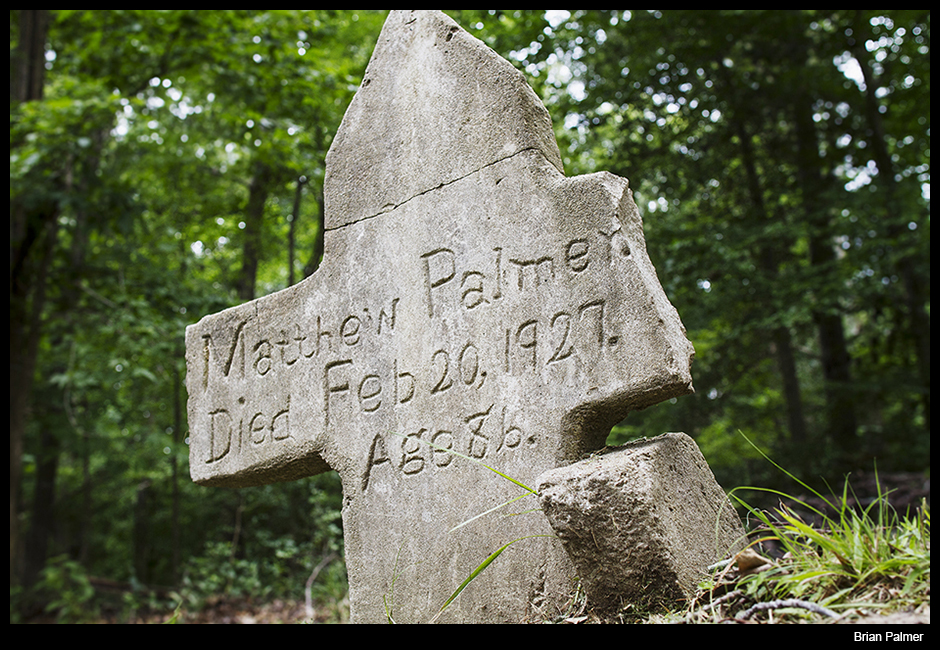
Camp Peary–Armed Forces Experimental Training Activity, VA—Headstone of Mat Palmer at Old Orchard Cemetery, an abandoned black cemetery at Camp Peary. July, 2012.
Everything—my move to the South, my photography of Virginia cemeteries—starts with my father’s death in 2011 and my wife’s discovery of a color snapshot in his scrambled photo archive. (My dad, Eddie, had been an amateur photographer since the early 1950s, but never a very organized one.) In the image that Erin found, nine African American seniors, including my dad and aunt Ethelyn, stand behind two headstones in what appears to be a clearing in a forest. Only one stone bears a legible name: Mat Palmer. My great-grandfather, about whom I knew little.
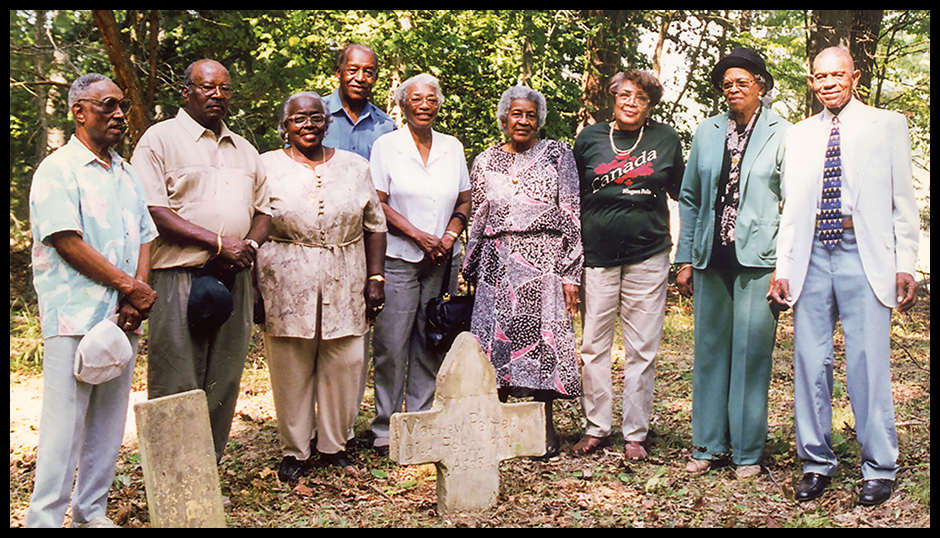 Descendants of people interred at Old Orchard Cemetery pose behind the graves of Mat and Julia Palmer. Second from left is Edward Palmer, father of Brian Palmer. Camp Peary–Armed Forces Experimental Training Activity, VA, 1998, Department of Defense photo.
Descendants of people interred at Old Orchard Cemetery pose behind the graves of Mat and Julia Palmer. Second from left is Edward Palmer, father of Brian Palmer. Camp Peary–Armed Forces Experimental Training Activity, VA, 1998, Department of Defense photo.
But I knew exactly where they were: Camp Peary, a top-secret military and CIA base built on property that the forebears of the people in the photo had once owned. In 1942 and ’43, the Navy had taken their land, their homes, businesses, churches—their entire town, Magruder—and spit out the people to build a wartime training facility. This happened all over the country, so it wasn’t a unique occurrence. The government took roughly two million acres of private property during World War II. But this little corner of southeastern Virginia, and its African American residents in particular, had been hammered by land takings and dispossessions for decades, centuries. As much as I was compelled by a desire to learn more about family history, I was really excited by the idea of setting foot on one of the nation’s most classified military installations. So I submitted a request. (As a blood relative of a person interred on base, I am allowed to visit, subject to approval of the base commander and to a security check.)
A public affairs officer and a base police office escorted me and a group of descendants I had organized to the graveyard, Old Orchard. This was one of Magruder’s black cemeteries. It was as humble as it looked in the photo; the burial ground had been allowed to revert to nature, but personnel had raked the field before our arrival.
We were then taken across the base to the white community’s cemetery and church. Both had been well-tended. (The town’s two black churches were razed.) But it was the grave of the Unknown Confederate Soldier that stopped me in my tracks. It was an arresting sight, this tribute to men who had fought to keep my ancestors enslaved, given pride of place on a United States military installation. I was shocked and then enraged.
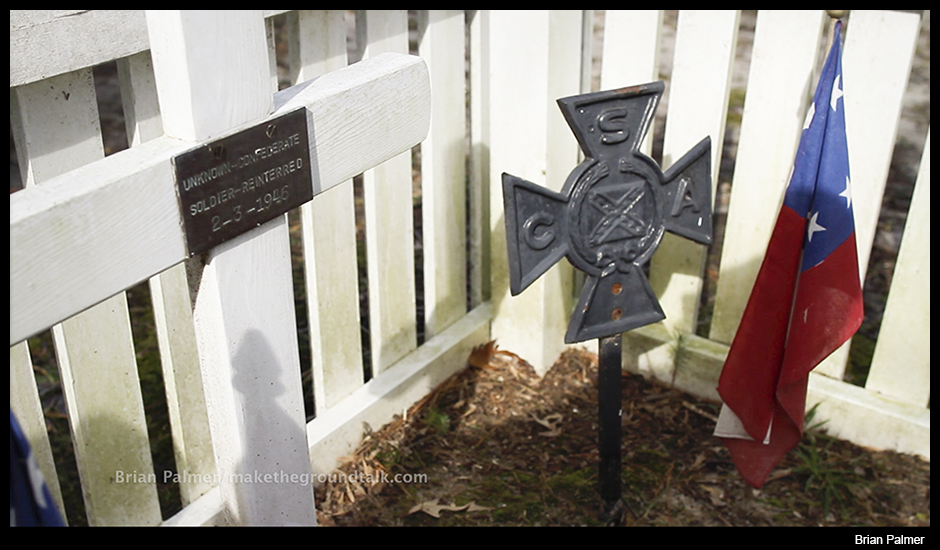 Grave of the Unknown Confederate Soldier in the cemetery of the former York River Presbyterian, once the church of the white community of Magruder, the town uprooted to build the base. February, 2012.
Grave of the Unknown Confederate Soldier in the cemetery of the former York River Presbyterian, once the church of the white community of Magruder, the town uprooted to build the base. February, 2012.
Magruder matters to me because my dad was born there, as were his parents. His parents’ parents, Mat and Julia Fox Palmer, had settled there, on the swampy, less-than-desirable land, years after they escaped slavery. They passed on this land to their sons and daughters. Mat had served in the United States Army’s segregated black fighting force during the Civil War, we learned later. As I stared at the Confederate memorial, I thought, the traitors are celebrated at Camp Peary, not the men and women who fought to liberate themselves—and who had to continue fighting for first-class citizenship.
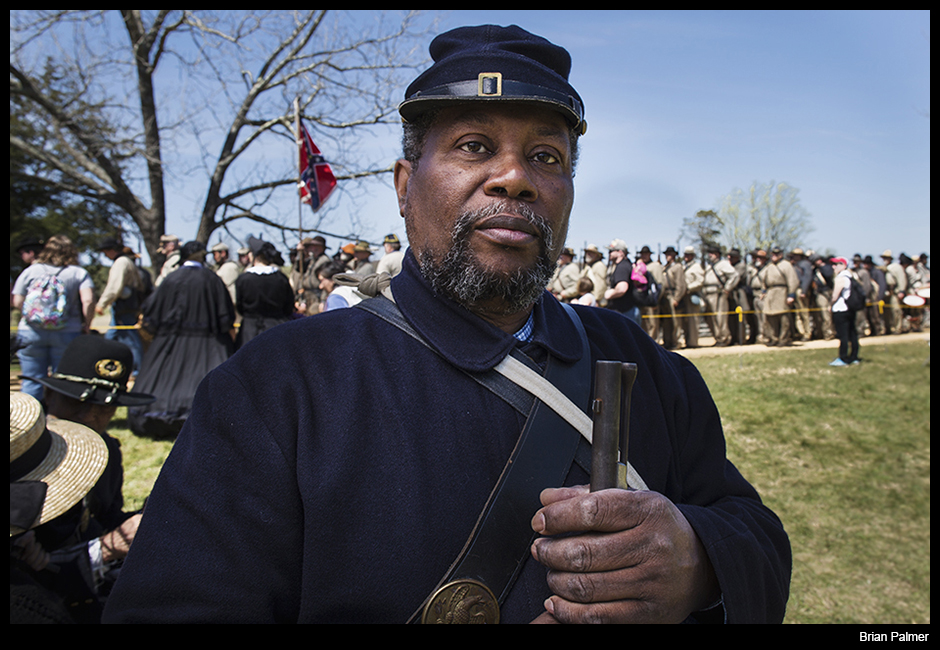 Reenactor interpreting a soldier of the United States Colored Troops, The U.S. Army’s black fighting force, during ceremony marking the 150th anniversary of the Confederate surrender at Appomattox Courthouse, VA, April 2015.
Reenactor interpreting a soldier of the United States Colored Troops, The U.S. Army’s black fighting force, during ceremony marking the 150th anniversary of the Confederate surrender at Appomattox Courthouse, VA, April 2015.
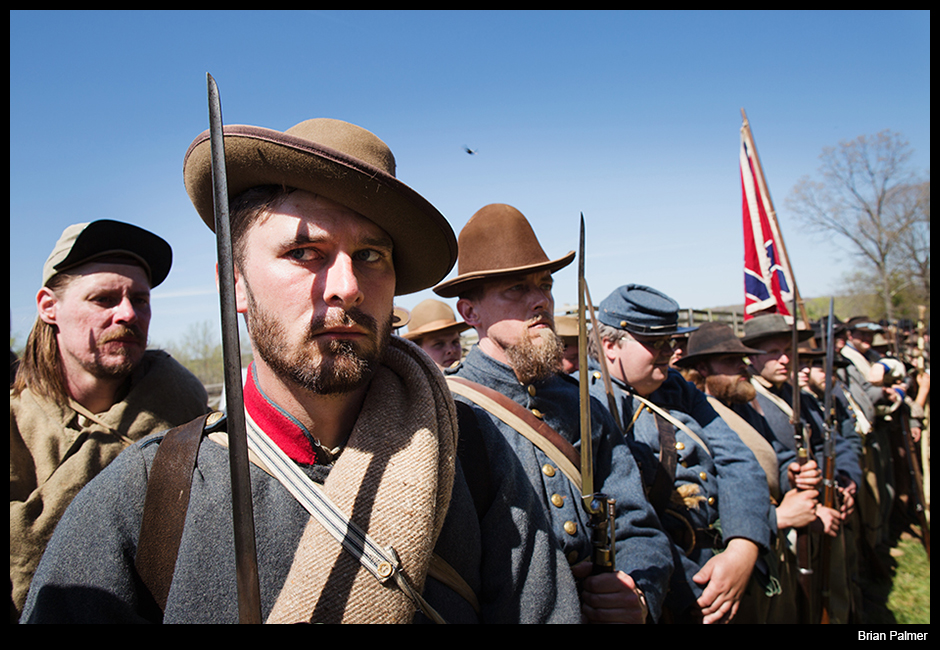 Confederate reenactors at ceremony marking the 150th anniversary of General Robert E. Lee’s surrender to General Ulysses S. Grant, United States Army, Appomattox Courthouse, VA, April 2015.
Confederate reenactors at ceremony marking the 150th anniversary of General Robert E. Lee’s surrender to General Ulysses S. Grant, United States Army, Appomattox Courthouse, VA, April 2015.
My wife and I decided to make a documentary, Make the Ground Talk, about these stories and our journey to unearth them. Initially, we would travel south from Brooklyn to shoot and interview when we had time and money. We’d meet promising interviewees, including former Magruderites and their descendants, spend a couple of days with them, and then leave. That’s no way to build relationships or to make a meaningful documentary. It didn’t matter that I had roots in the community. We were outsiders. So we moved to Virginia in 2013.
I shoot stills as we shoot video for the documentary. The still imagery has become a subset of the documentary, a way for me to try to crystallize history as we work to tell this story from the pieces of the black past that remain. I have developed a distinct body of work out of my Make the Ground Talk photos, images I have made at East End Cemetery, an abandoned, overgrown burial ground that served Richmond’s black community at its height—another microcosm of the African American experience.
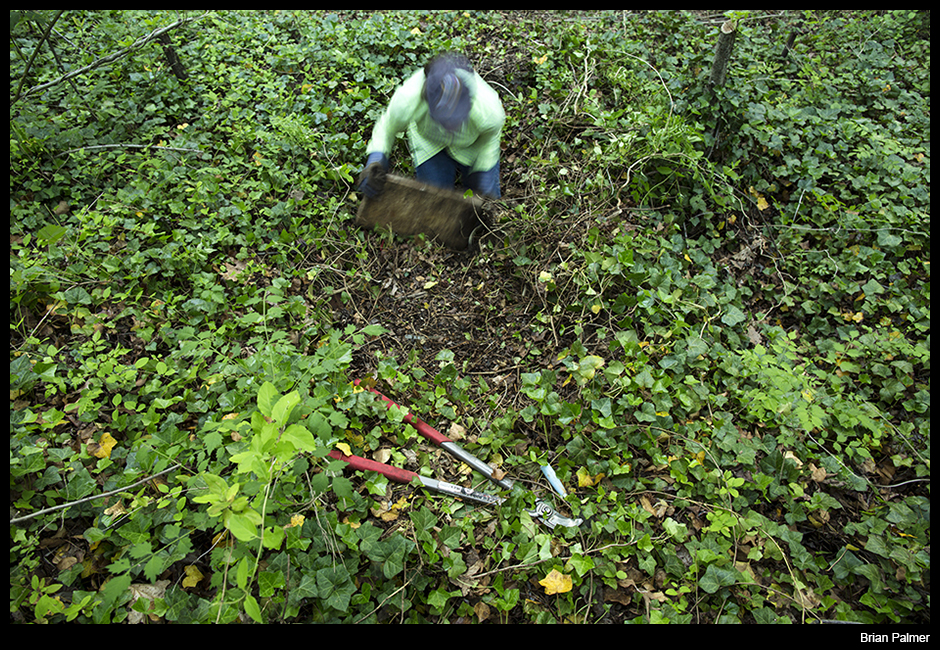 Volunteer unearths and disentangles a grave marker from decades of overgrowth at East End Cemetery, an abandoned historic black burial ground in Henrico County and Richmond, VA, May 2015.
Volunteer unearths and disentangles a grave marker from decades of overgrowth at East End Cemetery, an abandoned historic black burial ground in Henrico County and Richmond, VA, May 2015.
The anger I felt during that first visit to Camp Peary hasn’t gone away, but something else has grown beside it. To be connected to my history—to ancestors that I did not know I had — is immensely powerful. But there is more to it than this. In finding and telling the stories of Mat, Julia, and Magruder—and related stories of the African American past—we are reclaiming fragments of experience that were nearly erased, not by accident but by design.
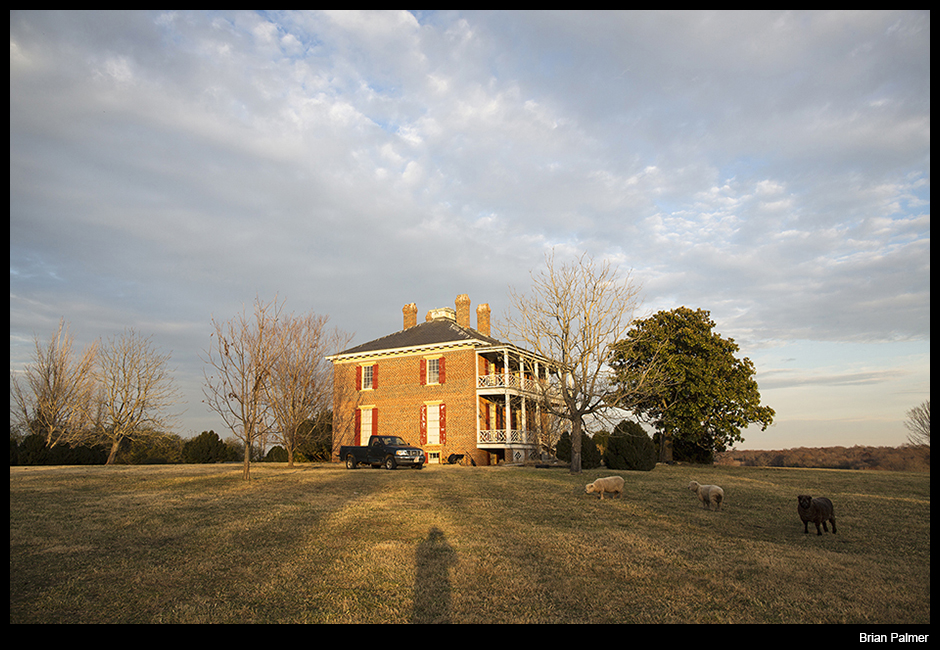 Snowden, home of Mat Palmer’s last owner, Goochland County, VA, November 2012.
Snowden, home of Mat Palmer’s last owner, Goochland County, VA, November 2012.
Before 1863, when the Emancipation Proclamation came into force in some parts of the South, meaningful facts about people such as Mat and Julia, who were deemed property, were not recorded. After the Civil War, white men of privilege and power sought to retain black labor by any means necessary. They rendered blacks as buffoons and criminals in their newspapers and books, because if you can prevent people from telling their own story on their terms—not to mention denying them the freedom to live as they see fit—you inhibit their ability to build identity, community, and power. It’s no coincidence that here in Virginia, as black men and women began rising to positions of influence, efforts to drive them back into subservience became particularly vigorous. These elites did serious damage to the black community with this near-erasure and these distortions—we live with that legacy—but they did not destroy it. To reclaim such stories, in words and images, is to restore to people a kind of spiritual and intellectual power.
In the following posts, I will focus on my documentation of East End and the efforts to reclaim it, physically and historically.
(Photographs and text by Brian Palmer)
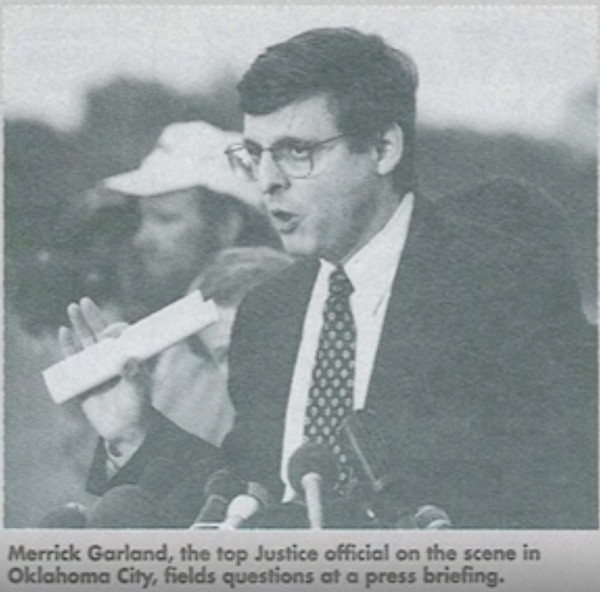
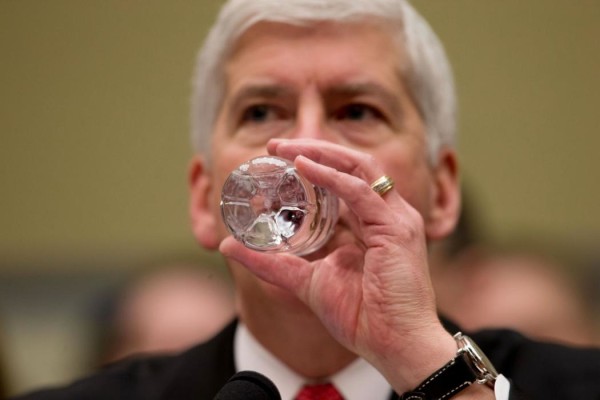
Reactions
Comments Powered by Disqus